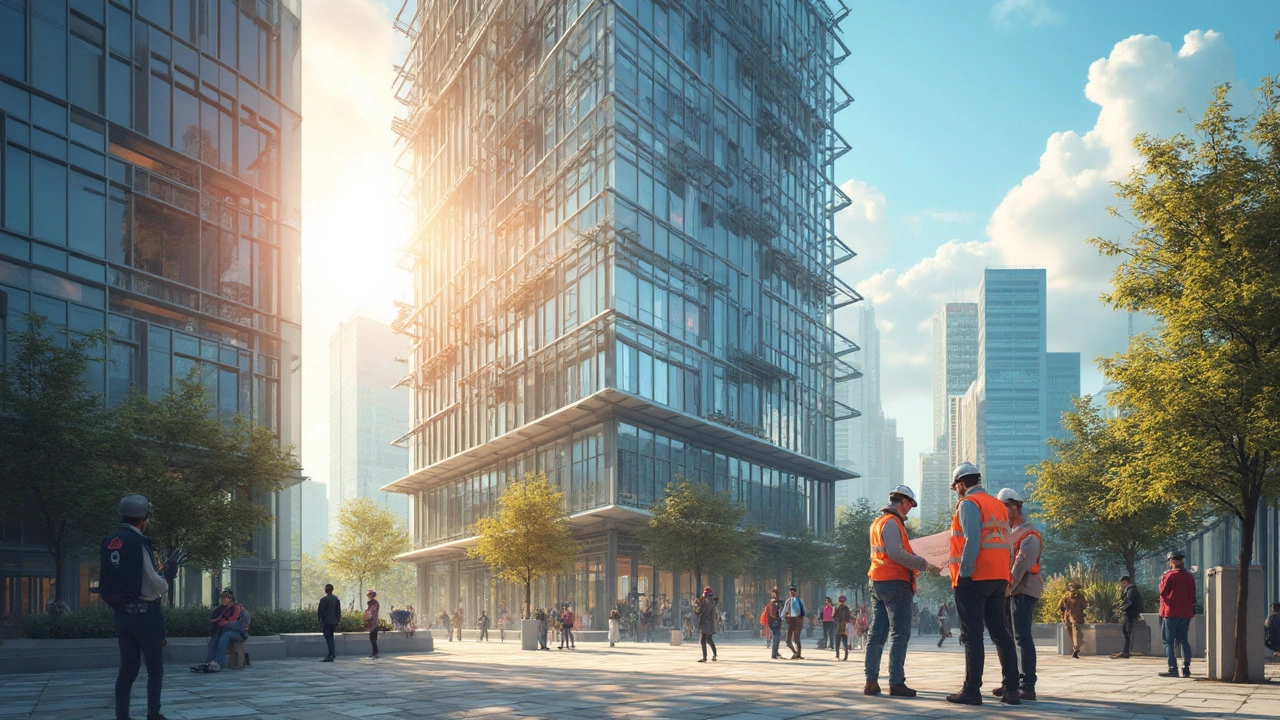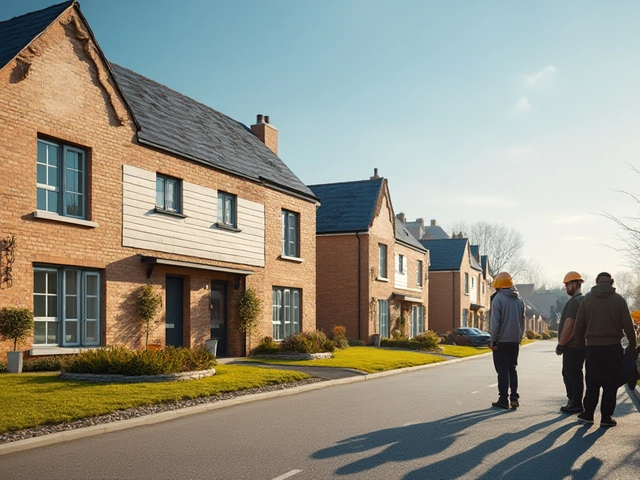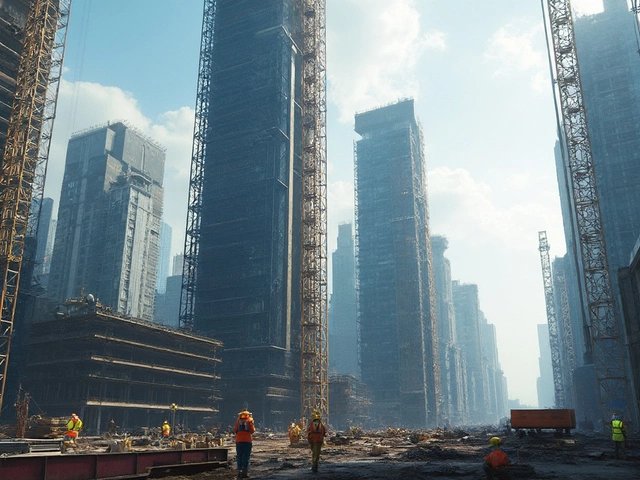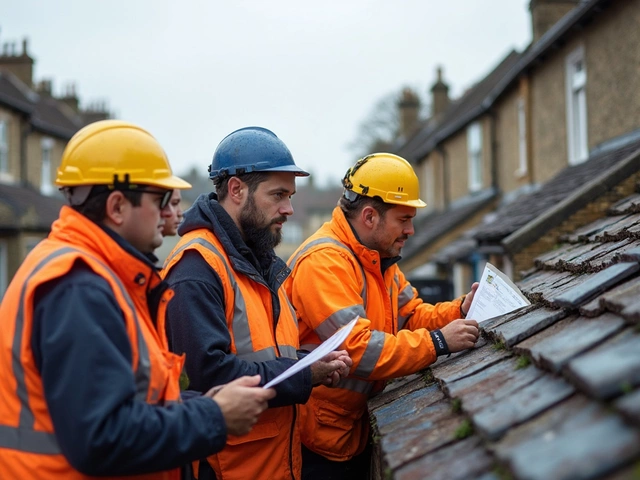
So, you're curious about what makes civil construction and commercial construction tick, right? These two types of building work might seem similar on the surface, but they're like apples and oranges in the construction world. Civil construction is all about the infrastructure that makes our daily life possible—think roads, bridges, and tunnels. On the other hand, commercial construction involves the buildings where we shop, work, and grab our morning coffee.
Understanding what sets them apart can save you headaches, especially if you're gearing up for a construction project. Each has its own set of rules, materials, and even team dynamics. Dive in, and you’ll see why having the right insights might just make your next project a whole lot smoother. Ready to explore what each type entails and how it might affect your plans? Let’s roll up our sleeves and dig into the nuts and bolts of these construction worlds.
- Defining Civil and Commercial Construction
- Types of Projects Involved
- Regulations and Codes
- Materials and Techniques
- Project Management Differences
- Choosing the Right Approach for Your Needs
Defining Civil and Commercial Construction
Alright, let’s break this down. First up, civil construction. This area is big on infrastructure—think highways, airports, water systems, and bridges. It's all about creating stuff that keeps towns and cities running smoothly. Civil construction projects are usually funded by the government because they serve the public interest. Picture those massive roadworks you’ve been stuck in traffic behind—yeah, that’s civil construction working its magic.
Switch gears to commercial construction, and you'll notice a shift. This is about creating spaces for business use, like towering office buildings, chic retail spaces, and bustling shopping centers. It's often privately funded by companies or developers aiming to make a profit. If you’ve been in a skyscraper or done some shopping recently, you’ve stepped into the world of commercial construction.
Now, these terms can sometimes cross paths, especially with mixed-use developments where residential, commercial, and other facilities share space. However, at their core, civil is all about public infrastructure and commercial is about creating usable spaces for business and commerce.
Here's a quick visual to help:
| Aspect | Civil Construction | Commercial Construction |
|---|---|---|
| Focus | Infrastructure (roads, bridges) | Business Facilities (offices, malls) |
| Funding | Mostly Government | Private Companies/Developers |
| Main Goal | Public Service | Profit and Business Use |
Types of Projects Involved
When jumping into the world of construction, it's key to know what kinds of projects you'll be dealing with. This can help set expectations, figure out costs, and understand timelines. Let's break down the types of projects for both civil construction and commercial construction.
In the realm of civil construction, the focus is on infrastructure projects that keep a city running smoothly. Think about roadways, bridges, tunnels, and even airports. These are the massive, often government-initiated projects that shape our environment. These jobs require large-scale planning and can influence entire communities. In today's digital age, smart highways and sustainable materials are becoming more popular to meet modern demands.
On the flip side, commercial construction includes projects that revolve around buildings meant for businesses and public services. From office buildings and shopping malls to hotels and restaurants, this type of construction supports economic activity. It involves understanding the needs of companies and their clients. Ever notice how a new coffee shop seems to pop up overnight? That's commercial construction in action.
Here's a quick glance at some typical projects:
- Civil Construction: Highways, bridges, dams, railways, and water treatment plants.
- Commercial Construction: Office complexes, retail spaces, warehouses, healthcare facilities, and educational buildings.
Getting these projects off the ground requires different expertise. For instance, civil construction often tackles tricky environmental and land-use issues, while commercial projects focus on design and meeting business needs. So, when you're planning, keep in mind what your project involves to ensure you have the right resources and team in place.
Regulations and Codes
When it comes to civil construction and commercial construction, the regulations and codes are like the rulebook every builder has to play by. While both fields demand strict adherence to safety and quality, the specifics differ quite a bit.
In civil construction, you’re usually dealing with public projects, like highways and bridges, and this means heaps of oversight. There are federal, state, and local codes that dictate how things should be built. These rules ensure the infrastructure can handle public use and natural wear and tear. For instance, the American Association of State Highway and Transportation Officials (AASHTO) provides guidelines that are non-negotiable.
On the flip side, commercial construction involves buildings like offices and retail stores. These projects follow the International Building Code (IBC), which covers everything from structural integrity to fire safety and plumbing. But it doesn’t stop there—zoning laws often tell you what kind of business can go where, and even how much parking you need for a shopping center.
Both types of construction need permits. For commercial projects, you might need specific permits for things like signage or occupancy. On the civil side, environmental impact assessments can add layers of red tape, especially if your bridge or road might affect local ecosystems.
- Permits and Certifications: Always know what paperwork you need beforehand. Missing a permit can mean costly delays.
- Inspections: Expect multiple inspections throughout the project to make sure everything is up to code.
- Safety Standards: Both fields need to comply with the Occupational Safety and Health Administration (OSHA) standards for worker safety.
Let’s not forget about changes. Codes can update every few years. What was okay last year might not fly today, so staying on top of these changes is vital for anyone in the industry. Whether you're doing commercial construction or civil construction, knowing the ins and outs of these codes is crucial to keeping projects running smoothly and safely.

Materials and Techniques
When we talk about civil construction versus commercial construction, the materials and techniques are like night and day. In civil construction, the focus is on durability and safety for massive structures like bridges and highways. That's why you'll often find materials like reinforced concrete and steel taking center stage.
Concrete, for example, is a superhero for civil construction because it's strong, durable, and can withstand all sorts of weather. Steel is like its trusty sidekick—super strong and flexible, perfect for withstanding the weight that bridges and tunnels face daily. Techniques here lean more toward large-scale operations, using cranes, bulldozers, and other heavy machinery to move and shape these materials.
Meanwhile, in commercial construction, it's all about meeting the specific needs of a building, whether it's an office, a mall, or a restaurant. Here, you'll see materials such as drywall, glass, and various types of flooring. Steel is also important here but often more for structural frames rather than standalone giant beams or support structures.
Commercial construction techniques involve a dance of different trades—plumbers, electricians, and carpenters all take turns. And technology's playing a bigger role these days. You’ve got BIM (Building Information Modeling) that helps in visualizing the entire structure and making design tweaks before the first brick is laid. Plus, with energy efficiency being the buzzword, materials like fiberglass insulation and solar panels are becoming common in commercial projects.
To break it down further, here's a quick comparison of materials typically used:
| Construction Type | Common Materials |
|---|---|
| Civil Construction | Reinforced Concrete, Steel, Asphalt |
| Commercial Construction | Drywall, Glass, Flooring, Steel Frames |
Choosing the right materials and techniques depends a lot on the specific goals of the project and the environment it's in. So, whether you’re looking to build a sprawling highway or the newest office high-rise, understanding this is key to making some solid construction choices.
Project Management Differences
Getting the hang of project management in civil construction and commercial construction can feel like comparing apples to oranges. Each brings its distinct vibe and set of challenges, so let's break down how they differ, shall we?
First off, civil projects often stretch over vast areas and long timelines—take highways and airports, for example. They're like marathons, needing intensive planning, coordination between various public bodies, and a strong grip on environmental regulations. Plus, they deal with unpredictable elements like weather, which can throw a wrench in even the best-laid plans.
Meanwhile, commercial projects are more like sprints. Think of office buildings or shopping malls. They often have tighter deadlines and focus heavily on meeting the needs of specific businesses. The project manager in commercial construction has to balance cost, speed, and quality like a juggling act. Budget constraints usually play a big role here, and making quick decisions is part of the daily grind.
"In commercial construction, the key is speed. Business owners want their space up and running to start generating revenue. It's a race against time," says Kevin Ramirez, a seasoned project manager in the field.
Both types demand rock-solid leadership skills, but the pace and focus differ. Civil construction deals with public interest, which adds a layer of complexity, especially when securing permits and meeting community standards. On the other hand, commercial construction is driven by business goals, which can sometimes push innovation to the forefront.
Here's a quick comparison to sum it up:
| Aspect | Civil Construction | Commercial Construction |
|---|---|---|
| Project Scale | Large-scale infrastructure | Business-focused buildings |
| Timeline | Long, uncertain | Tight, deadline-driven |
| Focus | Public needs | Business demands |
| Complexity | High, multi-agency coordination | Moderate, client-specific |
So, whether you're diving into civil construction or tackling a commercial construction project, understanding these management nuances can steer you clear of potential pitfalls. Keep these differences in mind, and you'll be better equipped to handle whatever comes your way!
Choosing the Right Approach for Your Needs
Alright, so you're figuring out whether to dive into a civil construction or commercial construction project—tough call, isn't it? The right choice really comes down to what you're aiming to build and the goals you're chasing.
For one, think about the type of structure you need. If it's about infrastructure, like a new highway or a bridge, civil construction’s your gig. These projects often connect larger communities and require heavy-duty planning with a focus on logistics. It usually involves government and large public stakeholders and is all about functionality to improve public life.
But if your sights are set on a shopping mall, office complex, or even the latest trendy restaurant, then you want to lean towards commercial construction. These projects revolve around spaces that people visit daily, so aesthetics, flow, and user experience play a big role. You'll work more with private investors and businesses, so there's a lot more room for creative input compared to civil projects.
Now, consider the budgets and timelines involved. Civil projects often have larger budgets and longer timelines because of their scale. Think about government-funded highways that take years to plan and build. Commercial projects tend to have tighter timelines and budgets. Here's the kicker: the quicker turnaround in commercial construction often means fast-paced decisions and adjustments on the fly.
Both types of projects demand specific team strengths. Civil projects require experts in large-scale logistics, while commercial projects benefit from architects focused on utilitarian designs. Team up with professionals who have the experience and know-how for your specific goals. Even if it means a steeper upfront cost, having the right expertise on board can save you from costly mistakes down the line.
Finally, remember that both types of construction must adhere to different sets of regulations and zoning laws. Get to know these codes early on to avoid any legal roadblocks. It's a good idea to engage with local officials or consultants familiar with requirements for your project type.
| Aspect | Civil Construction | Commercial Construction |
|---|---|---|
| Main Focus | Infrastructure, public works | Business-related buildings |
| Typical Clients | Government, public sector | Private businesses, developers |
| Typical Costs | Higher, due to scale | Varies, generally more controlled |
| Project Timeline | Long-term | Shorter-term |
Your choice between civil and commercial construction isn't just about what you want to build, but how you want to approach the construction process. Weigh these factors carefully, and your decision will likely become clearer!




